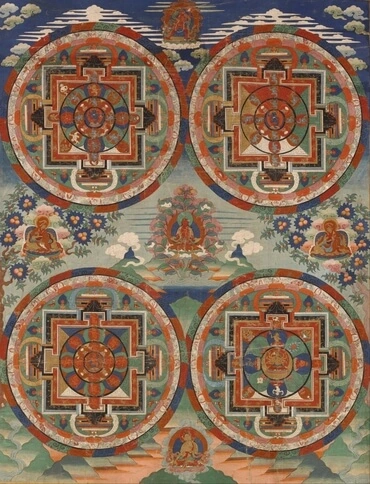1
അഞ്ചു മുഴം നീളവും അഞ്ചു മുഴം വീതിയുമായി ഖദിരമരംകൊണ്ടു യാഗപീഠം ഉണ്ടാക്കേണം; യാഗപീഠം സമചതുരവും മൂന്നു മുഴം ഉയരവും ആയിരിക്കേണം.
2
അതിന്റെ നാലു കോണിലും കൊമ്പുണ്ടാക്കേണം; കൊമ്പു അതില്നിന്നു തന്നേ ആയിരിക്കേണം; അതു താമ്രംകൊണ്ടു പൊതിയേണം.
3
അതിലെ വെണ്ണീര് എടുക്കേണ്ടതിന്നു ചട്ടികളും അതിന്റെ ചട്ടുകങ്ങളും കിണ്ണങ്ങളും മുള്കൊളുത്തുകളും തീക്കലശങ്ങളും ഉണ്ടാക്കേണം; അതിന്റെ ഉപകരണങ്ങളൊക്കെയും താമ്രംകൊണ്ടു ഉണ്ടാക്കേണം.
4
അതിന്നു താമ്രംകൊണ്ടു വലപ്പണിയായി ഒരു ജാലവും ഉണ്ടാക്കേണം; ജാലത്തിന്മേല് നാലു കോണിലും നാലു താമ്രവളയം ഉണ്ടാക്കേണം.
5
ജാലം യാഗപീഠത്തിന്റെ പകുതിയോളം എത്തുംവണ്ണം താഴെ യാഗപീഠത്തിന്റെ ചുറ്റുപടിക്കു കീഴായി വെക്കേണം.
6
യാഗപീഠത്തിന്നു ഖദിരമരംകൊണ്ടു തണ്ടുകള് ഉണ്ടാക്കി താമ്രംകൊണ്ടു പൊതിയേണം.
7
തണ്ടുകള് വളയങ്ങളില് ഇടേണം; യാഗപീഠം ചുമക്കുമ്പോള് തണ്ടുകള് അതിന്റെ രണ്ടു ഭാഗത്തും ഉണ്ടായിരിക്കേണം.
8
പലക കൊണ്ടു പൊള്ളയായി അതു ഉണ്ടാക്കേണം; പര്വ്വതത്തില്വെച്ചു കാണിച്ചുതന്നപ്രകാരം തന്നേ അതു ഉണ്ടാക്കേണം.
9
തിരുനിവാസത്തിന്നു പ്രാകാരവും ഉണ്ടാക്കേണം; തെക്കെ ഭാഗത്തേക്കു പ്രാകാരത്തിന്നു പിരിച്ച പഞ്ഞിനൂല്കൊണ്ടു ഒരു ഭാഗത്തേക്കു നൂറു മുഴം നീളത്തില് മറശ്ശീല വേണം.
10
അതിന്റെ ഇരുപതു തൂണും അവയുടെ ഇരുപതു ചുവടും താമ്രംകൊണ്ടും തൂണുകളുടെ കൊളുത്തും മേല്ചുറ്റുപടികളും വെള്ളികൊണ്ടും ആയിരിക്കേണം.
11
അങ്ങനെ തന്നേ വടക്കെ ഭാഗത്തേക്കു നൂറു മുഴം നീളത്തില് മറശ്ശീല വേണം; അതിന്റെ ഇരുപതു തൂണും അവയുടെ ഇരുപതു ചുവടും താമ്രംകൊണ്ടും തൂണുകളുടെ കൊളുത്തും മേല്ചുറ്റുപടികളും വെള്ളികൊണ്ടും ആയിരിക്കേണം.
12
പടിഞ്ഞാറെ ഭാഗത്തേക്കു പ്രാകാരത്തിന്റെ വീതിക്കു അമ്പതു മുഴം നീളത്തില് മറശ്ശീലയും അതിന്നു പത്തു തൂണും അവേക്കു പത്തു ചുവടും വേണം.
13
കിഴക്കെ ഭാഗത്തേക്കും പ്രാകാരത്തിന്റെ വീതി അമ്പതു മുഴം ആയിരിക്കേണം.
14
ഒരു ഭാഗത്തേക്കു പതിനഞ്ചു മുഴം നീളമുള്ള മറശ്ശീലയും അതിന്നു മൂന്നു തൂണും അവേക്കു മൂന്നു ചുവടും വേണം.
15
മറ്റെ ഭാഗത്തേക്കും പതിനഞ്ചു മുഴം നീളമുള്ള മറശ്ശീലയും അതിന്നു മൂന്നു തൂണും അവേക്കു മൂന്നു ചുവടും വേണം.
16
എന്നാല് പ്രാകാരത്തിന്റെ വാതിലിന്നു നീലനൂല്, ധൂമ്രനൂല്, ചുവപ്പു നൂല്, പിരിച്ച പഞ്ഞിനൂല് എന്നിവകൊണ്ടു ചിത്രത്തയ്യല് പണിയായി ഇരുപതു മുഴം നീളമുള്ള ഒരു മറയും അതിന്നു നാലു തൂണും അവേക്കു നാലു ചുവടും വേണം.
17
പ്രാകാരത്തിന്റെ എല്ലാ തൂണുകള്ക്കും വെള്ളികൊണ്ടു മേല്ചുറ്റുപടി വേണം; അവയുടെ കൊളുത്തു വെള്ളികൊണ്ടും ചുവടു താമ്രംകൊണ്ടും ആയിരിക്കേണം.
18
പ്രാകാരത്തിന്നു നാനൂറു മുഴം നീളവും എല്ലാടവും അമ്പതു മുഴം വീതിയും അഞ്ചു മുഴം ഉയരവും ഉണ്ടായിരിക്കേണം; അതു പിരിച്ച പഞ്ഞിനൂല്കൊണ്ടും ചുവടു താമ്രംകൊണ്ടും ആയിരിക്കേണം.
19
തിരുനിവാസത്തിലെ സകലശുശ്രൂഷെക്കുമുള്ള ഉപകരണങ്ങളൊക്കെയും അതിന്റെ എല്ലാകുറ്റികളും പ്രകാരത്തിന്റെ എല്ലാകുറ്റികളും താമ്രംകൊണ്ടു ആയിരിക്കേണം.
20
വിളകൂ നിരന്തരം കത്തികൊണ്ടിരിക്കേണ്ടതിന്നു യിസ്രായേല്മക്കള് വിളക്കിന്നു ഇടിച്ചെടുത്ത തെളിവുള്ള ഒലിവെണ്ണ നിന്റെ അടുക്കല് കൊണ്ടുവരുവാന് അവരോടു കല്പിക്ക.
21
സമാഗമനക്കുടാരത്തില് സാക്ഷ്യത്തിന്നു മുമ്പിലുള്ള തിരശ്ശീലെക്കു പുറത്തു അഹരോനും അവന്റെ പുത്രന്മാരും അതിനെ വൈകുന്നേരം മുതല് പ്രഭാതം വരെ യഹോവയുടെ മുമ്പാകെ കത്തുവാന്തക്കവണ്ണം വെക്കേണം; ഇതു യിസ്രായേല്മക്കള്ക്കു തലമുറതലമുറയായി എന്നേക്കുമുള്ള ചട്ടമായിരിക്കേണം.







